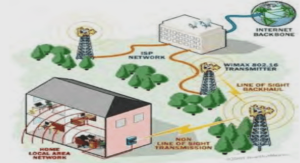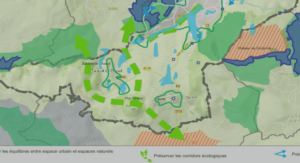1,600 gardens and farms have been reported in 2018 in Detroit. More than 24,000 individuals and families feed themselves at least occasionally with fruits and vegetables grown in the city (KGD; 2018). Beyond splashy headlines and well-intentioned movies, urban farms and gardens have blossomed in neighbourhoods hardly hit by deindustrialization and depopulation: the city population has fallen from roughly 1.8 million inhabitants in 1950 to 677,000 in 2015. In 2012, 36% of the residents lived below the poverty line of $11,770/ year. As one of my interviewees told me once, “If you want to grow vegetables for your own, it’s an activity, there’s nothing wrong with that. But in a city like Detroit with 40 square miles with surplus land without a purpose [103,6 km², 28% of the city], without a budget, the answer isn’t ‘Hey, we should all garden’” (Mike; 22nd of January).
But some residents do. Moreover, they grow, process, distribute, sell their fruits and vegetables in restaurants, in farmers’ markets, Community Supported Agriculture networks [AMAPs], organize themselves in cooperatives, engage in food justice movements, claims their right before City Council. What are these people trying to do, seriously? Let’s take these people seriously. The following document is the result of a ten-months inquiry and a three-months qualitative fieldwork in the City of Detroit, Michigan, between January and April 2019. This research aims at understanding how urban farmers financially and politically sustain themselves in 2019 Detroit.
By ‘sustaining themselves’, we mean the farmers’ capacity to provide themselves with resources vital for their economic activity (land, labour, tools, greenhouses, seeds) as well as their capacity to organize themselves collectively for advocating before city government, convincing new customers, creating alternative models of production. Remains the urban farming oxymoron (Smit et al.; 2001). Because urban farming covers a wide range of practices, we will limit ourselves to a descriptive approach for now: what is urban farming if not ‘the production of food and non-food plant and tree crops, and animal husbandry, both within and fringing urban area’ (OECD; 1998)? Although the terms of ‘farming’ and ‘agriculture’ have been discussed in international economics of food (Bernstein; 2010), they will cover the same reality here: they refer to the stages of growing, processing, distributing and selling food and non-food plants and crops in farms or gardens within city limits.
In order to get a sense of farmers’ political economics, we investigated patterns of grant financing in Detroit between 2010 and 2015. Then, we combined these first insights with a qualitative inquiry (26 in-depth interviews, multi-site ethnographies) realized during the fieldwork in the city.
Detroit history and the urban farming world
The history of Detroit during the 20th century is remarkable on many respects. The magnitude of its development during the first half of the century is marked by the annexation of 22 neighbouring cities between 1906 and 1926 to fuel space for city’s immigration, reaching a 370.08 km² footprint (3.5 times Paris inner city). By contrast, the magnitude of its population loss on the second half, from 1,850,000 in 1950 to 677,116 in 2015, has left a physical landscape of vacant land and brownfields .
However, in 2019, years of shrinkage policies aiming at reducing the share of vacant land in the city have profoundly changed this post-apocalyptic picture (a). This unused land has been perceived by Detroit residents, entrepreneurs, city officials and sometimes foreigners not only as a burden but also as an opportunity for development, urban farming being one of those (b).
Detroit’s decay and ‘smart-shrinkage policies’
Detroit has a longstanding history of urban decline, losing more than half of its inhabitants in 30 years. The city came to the spotlight as one of the most affected by the economic crisis in the 70’s and the following waves of deindustrialization (Downs; 1973, Sugrue; 1996, Downs; 1997, Beauregard; 2001). The city also cumulated high unemployment and crime rates, critical deindustrialization in the car industry, massive migrations to the suburbs and to southern Sun Belt states. Along with Buffalo, NY, Cleveland, OH, and Pittsburgh, PA, Detroit shed a dull light to the ‘urban crisis’ phenomenon (Moynihan; 1966). Research debates early focused on economical causes of urban decline only (Downs; 1973, Norton; 1978, Bradbury et al.; 1981) Recent inquiries however, integrated the racial dimension of such crisis, arguing that land abandonment come from deindustrialization, unchecked suburban growth and racial segregation (Sugrue; 1996, Hackworth; 2015), while others pointed out the worldwide its global dimension (Oswalt; 2006, Fol and Cunnigham-Sabot; 2010). The latter insists on the fact that cities do not ‘shrink’ (reduce in size) but rather expand while losing population, producing severe land abandonment. If causes of urban decline seem nowadays to create a relative consensus among scientists, debates are quite intense when it comes to operational dimensions of shrinkage and their outcomes.
Indeed, ‘smart-shrinkage’ or ‘rightsizing’ refer to two items: 1/strategies developed by local governments to manage population decline 2/instruments and tools to manage it. Rybcynski (1995) first formalized the issue of reducing city size as a concrete policy goal, arguing for a more qualitative vision of urban growth, as well as Popper and Popper who popularized the term ‘smart decline’ (Popper and Popper; 2002). On the policy strategy side, debates focused on whether reducing expenditures while raising taxes or narrowing in scope the mix of public services (Eggers; 1996, Osborne and Gaebler; 1992). General strategies observed in shrinking cities were those of “moving from comprehensive re-planning of government services, to processing improvement tactics for existing responsibilities, to seeking land use reforms” (Anderson; 2011). On the instrument side, recent focus has been made on land management tools such as reducing the material city size by demolishing blight areas (Schwarz et al.; 2016) or developing comprehensive land management tools such as land banks (Schilling and Logan; 2008, Alexander; 2011). Detroit is often taken as a notorious example in these literatures: Jason Hackworth for instance, comparing American and Canadian rust belt cities in his article Why there is no Detroit in Canada?, presented the city in those terms: “The most extreme caseslike Detroit experienced heavy doses of deindustrialization, suburbanization and racialization” (Hackworth; 2015). Years of shrinking policies led by the successive local governments with Federal program funds have nonetheless transformed the city’s face (Anderson; 2011). Between 2014 and 2019, the Detroit Building Authority has torn down 17,577 buildings transforming brownfields into empty lots (DBA; 2019). Nowadays, Detroit’s land emptiness is less and less seen as a burden but rather as an opportunity.
Detroit’s Revival, urban land claims and the place of urban farming
Evidences of the “Detroit frontier, with its lawless appearance and broad opportunities” as if the city was the new Western frontier (Hand and Gregory; 2017) are found in the city’s image pictured in national newspapers. Dozens of articles demonstrating Detroit’s ‘comeback’ with entrepreneurial ‘game changers’ (Baltimore News; 2018, New York Times; 2018, Financial Times; 2018). All of them present the city as an opportunity for those who would like to start a new life from scratch. Urban farms have deserved a similar media treatment, from portraits of entrepreneurial farmers developing urban ‘agrihoods’ (Crain’s Detroit Business; 2016) to French documentaries on urban farming alternatives (Demain; 2015), presenting farmers at the forefront of social and environmental innovations. In this regard, urban farming has received a specific reception in the form of a “mutual benefits” narrative described by Paddeu: “shrinkage is seen as an opportunity for urban agriculture, and urban agriculture as a beneficial tool for shrinking cities” (Paddeu; 2017). Authors posited that land availability in cities like Detroit would favour the development of innovative ‘green uses’ (Schilling and Logan; 2008, LaCroix; 2010). Moreover, the city has a long benevolent history with urban farming, from mayor Hazen S. Pingree’s “Potato Patch Plan” of 1893, a city program opening vacant land for gardening in recession time, to 1975 Coleman Young’s “Farm-a-Lot” project providing technical guidance and machine tillage to residents willing to garden their empty side lots (City of Detroit; 1975). The other side of the picture has been presented by sociological inquiries in the field of food justice, showing how this new immigration resulted in new forms of gentrification (Lees; 2008, Dooling; 2009, Pride; 2016) or recalled ancient form of colonialism (Safransky; 2014). Urban farming, rather than being a neutral green alternative, has raised community concerns due to its outstanding scale of propagation. Concerns about land ownership and community land claims in Detroit have emerged as a key issue in this regard. Researchers demonstrated that in Detroit paradoxically, high rates of land vacancy do not lead to land availability for the residents or small-scale farmers (Paddeu; 2017, Pothukuchi; 2017) while some large-scale farms can negotiate directly with the mayor’s office to acquire hundreds of acres (Crain’s Detroit Business; 2019). In this context, the conception, vote and implementation of the urban agriculture ordinance (UAO) between 2010 and 2013 has got our attention. The participative approach for policy formulation developed by Katheryn L. Underwood from the City planning commission gathered farmers in the Urban Agriculture Working group in order to draft the ordinance proposal, then submitted to diverse public outreach events for residents and farmers’ meetings (Paddeu; 2015). As an outcome, urban farming was recognized as a possible land use within some regular zoning categories (residential and commercial), with limitations related to animals, tree and crop species (UAO; 2013).
General introduction |



